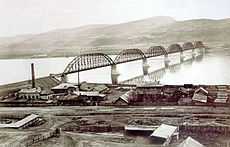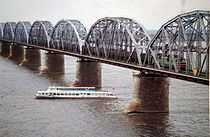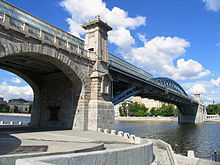Lavr Proskuryakov

Lavr Dmitrievich Proskuryakov (18 August 1858, the village of Borisovka, Voronezh Governorate – 14 September 1926, Moscow) was one of the foremost authorities on bridge engineering and structural mechanics in the Russian empire and the early Soviet Union.
Life and career
Lavr Proskuryakov was born on August 18, 1858, into a large peasant family. In 1884, he graduated from the Saint-Petersburg Institute of Railway Engineers and worked as a designer of bridges. Since 1887, he lectured at the same institute, and starting from 1896, Proskuryakov held the position of Full Professor at Moscow State University of Railway Engineering.
Even the early Proskuryakov's projects for the bridges across the rivers Western Bug (1885) and Sula in the Ukraine (1887) attract attention by their novelty and ingenuity. The drawings of those bridges were published by Professor L.F. Nikolai, the head of the bridge faculty at the Petersburg Institute of Railway Engineers, in his tutorial on bridge design for railway engineers.[1]
In the summer of 1895, Proskuryakov was sent abroad by the decision of the Institute academic council to take part in the International Railway Congress in London, as well as explore the local mechanical laboratories and bridges. Besides London, he visited laboratories in Paris, Zurich, Munich, Vienna and Berlin, and then went to the United States in order to get acquainted with the biggest bridge structures and local mechanical laboratories.[2]
Proskuryakov was the first in Europe to reject then existing lattice bridge trusses with lots of vertical and diagonal members, which were extremely difficult for truss analysis. Instead, he designed a statically determinate triangular web truss with the minimum number of diagonals, which allowed to ensure better stress distribution within a bridge structure under moving loads.


All the research and practical activities of Lavr Proskuryakov were aimed at the creation of a perfect bridge structure. And he managed to achieve his goal: this was the powerful 1,000 metres (3,300 ft) long railway bridge across the Yenisei near Krasnoyarsk, which was built during between 1896 and 1899. The steelwork of the bridge consisted of six spans, each 144.7 metres (475 ft) long and 21.64 metres (71.0 ft) height, amounting to 900 tons.[3] Each of the bridge‘s pier was equipped with a massive wedge-shaped cutwater on the upstream side dressed with granite slabs and designed to break up the current of the river and ice-blocks.
Thanks to its engineering and technical characteristics, the bridge was recognized as the longest in Russia and the second largest in Europe (the first one was in the Netherlands across the Lek River near Kuilenburg). Represented at the Exposition Universelle (1900), the Yenisei bridge's model received the Gold medal, while Proskuryakov himself went on to become one of the country's most prominent engineers. The bridge was subsequently approved by the UNESCO for inclusion in the World Heritage List.
While he was designing the Yenisei bridge's spans, Proskuryakov developed and introduced a completely new design — the original trusses with subdivided panels and upward-angled upper chords (similar to Schwedler truss). The engineer has also extended the theory of influence lines for the analysis of the bridge's trusses that allowed to accurately calculate the internal forces in every member in a truss resulting from a moving load. Since then, the theory of influence lines for the analysis of trusses has been used in structural designs both in Russia and abroad. Incidentally, the Yenisei bridge was the first in Russia, during the construction of which the incremental launching method was applied for the first time.
Essentially, the Yenisei bridge opened up a new era of the Russian bridge engineering. Proskuryakov's statically determinate trusses with subdivided panels and upward-angled upper chords were subsequently widely used by many other bridge engineers. In particular, such a system of spans (with a few changeups) was borrowed by Professor Nikolai Belelyubsky in the design of the rail bridge across the Volga River near Sviyazhsk.
Summarizing the practical results of Proskuryakov’s activities, it becomes clear that he managed to elaborate the most suitable types of spans for a variety of bridges. Proskuryakov has designed many unique multi-span bridges, including the bridges over Oka near Kashira (1897), Belev (1897) and Murom (1912), Vyatka on the Cherepovets-Vologda-Vyatka line (1902), Volkhov (1902), Amur near Khabarovsk (1916) on the Trans-Siberian Railway, and so forth. Yevhen Paton compared Proskuryakov's bridges to Pushkin's poems.
In 1903, at the discretion of the Society of the Moscow-Kazan Railway, L.D. Proskuryakov was among other bridge-design professionals, both domestic and foreign, who made a rough sketch for the bridge across the Volga River near Kazan with the largest span of 165 metres (541 ft) long, similar to the Yenisei bridge.
In 1904, Proskuryakov designed two arched steel double track rail bridges — Andreyevsky and Krasnoluzhsky — across the Moscow River for the Moscow Circular Railway. Both twin bridges were located within the city and their graceful appearance fully satisfied the demands, which were imposed to the urban constructions of the day. It is worth noting that it were the Russia's first steel railroad bridges, which had crescent arch spans.[4]

One more important achievement in the bridge engineering of Imperial Russia was the famous the Amur River Bridge near Khabarovsk that was also designed by Professor Lavr Proskuryakov. The bridge was constructed as a 2,590 metres (8,500 ft) long steel bridge that carried single rail track. Opened for traffic on October 5, 1916, the bridge marked the completion of Trans-Siberian Railroad.[5]
Similar to the Yenisei bridge, the piers of the Amur bridge had massive wedge-shaped cutwaters on the upstream side, which were designed as inclined planes toward the current for the purpose of preventing ice from piling up against the piers. The height of the bridge from the upper deck to the maximum water surface elevation reached 12 metres (39 ft). It allowed larger ships to pass underneath the bridge even at the highest summer water level in the Amur. The bridge cost the Russian treasury more than 13 million roubles — a colossal sum of money for those times.[6]
Proskuryakov was a strong proponent of the graphical method (or the dummy load method) for the analysis of trusses, which is based on the theory of influence lines. In the period 1891-1892, Proskuryakov held the elective course "The application of graphical statics in civil engineering practice". It is particularly remarkable that two years later the course became a core and even mandatory subject in the railway engineers training programme.
In 1896, while he was designing the bridge across the Kotorosl River, Proskuryakov for the first time worked out special tables to calculate the bearing strength or load-carrying capacity of a bridge during a train passage. Both the theory of influence lines and tables would greatly facilitate the procedures for truss analysis, so these practices eventually became ingrained in bridge engineering around the world.
Education activities
Proskuryakov was also a prominent educator and mentor of youth. He trained many talented scientists and engineers. His colleagues and apprentices, such as E.O.Paton, M.M.Filonenko-Borodich, I.P.Prokofiev, P.A.Velikhov, P.Y.Kamentsev and others, became nationally famous scientists in later times. The teaching methods of engineering mechanics developed by Professor Proskuryakov are now widely used in higher education.
In 1902, Proskuryakov published his first volume of structural mechanics that was titled "Strength of Materials". Later, in 1907, he also published the second volume, named "Structural Statics", as well as his scientific work "On the analysis of continuous trusses". Those works have been included into the golden fund of science. His two-volume handbook went through six editions during his lifetime. The seventh edition was published posthumously, and it has become a textbook for all technical institutes of the country.
-

Pushkinsky Bridge in Moscow (1905–07)
-

Another view of Pushkinsky Bridge Image:Prokudin-Gorskii-25.jpg|Bridge on the Trans-Siberian Railway in Perm
See also
References
Notes
External links and references
- (Russian) "Pioneer of the Russian Bridge Science"